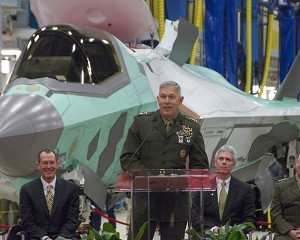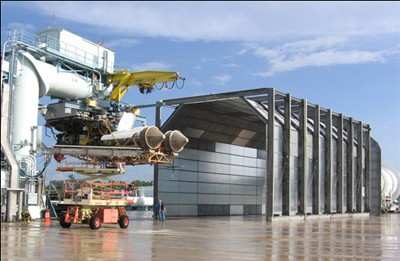B-Variant Intended To Replace Harriers, F/A-18
 Lockheed Martin
unveiled Tuesday its F-35B Lightning II, the first fighter to
combine stealth with short takeoff/vertical landing (STOVL)
capability and supersonic speed, to customers from the United
States Marine Corps, the United Kingdom's Royal Navy and Royal Air
Force, and the Italian Air Force and Navy.
Lockheed Martin
unveiled Tuesday its F-35B Lightning II, the first fighter to
combine stealth with short takeoff/vertical landing (STOVL)
capability and supersonic speed, to customers from the United
States Marine Corps, the United Kingdom's Royal Navy and Royal Air
Force, and the Italian Air Force and Navy.
Attendees at the rollout ceremony in Lockheed Martin's Fort
Worth, TX assembly plant included Marine Corps Commandant Gen.
James Conway (above). "The flexibility that the STOVL variant of
the F-35 will add to the contemporary Marine Air Ground Task Force
is amazing," Conway said. "This generational leap in technology
will enable us to operate a fleet of fighter/attack aircraft from
the decks of ships, existing runways or from unimproved surfaces at
austere bases. We find that capability extremely valuable."
The F-35B -- designed to replace Marine Corps AV-8Bs and F/A-18s
-- is one of three variants of the Lightning II. Its first flight
is planned for mid-2008, following a series of extensive ground
tests. The F-35A conventional takeoff and landing version began its
flight test program in December 2006; the F-35C, designed for
catapult launches and arrested recoveries aboard large US Navy
carriers, will make its inaugural flight in 2009.
"Think F/A-18 speed and maneuverability, AV-8B forward
deployment, F-22 stealth, and astonishing avionics," said Dan
Crowley, Lockheed Martin executive vice president and F-35 program
general manager. "It's a combination of technologies that may seem
like science fiction, but our abundantly-talented international
team has made it science fact."
The heart of the F-35B is a STOVL propulsion system comprising
the most powerful engine ever flown in a jet fighter, a
shaft-driven counter-rotating lift fan situated behind the cockpit,
a roll duct under each wing for lateral stability, and a rear
3-bearing swivel nozzle that vectors engine exhaust in the desired
direction.
During vertical or short takeoffs, or vertical landings, doors
above and below the lift fan open, and a clutch connecting the lift
fan to the engine drive shaft engages. A dorsal auxiliary engine
inlet opens to increase airflow to the engine. At the same time,
doors beneath the 3-bearing swivel nozzle open and the rear nozzle
pivots downward, deflecting engine thrust toward the ground. Roll
ducts under each wing also are engaged, keeping the aircraft
laterally stable. In this configuration, the F-35B can hover, land
vertically, take off in a few hundred feet fully loaded, or take
off vertically with a light load. When the aircraft transitions
from jet-borne to conventional wing-borne flight, the doors close
and the pilot can then accelerate to supersonic speeds. The system
is completely automatic.
The Lockheed Martin X-35B successfully demonstrated the
shaft-driven lift fan propulsion system in 2001, becoming the only
aircraft in history to execute a short takeoff, level supersonic
dash and vertical landing in a single flight.

The Pratt & Whitney F135 engine (shown above during a STOVL
test) will power the first series of F-35Bs. The F136, an
interchangeable engine under development by the GE Rolls-Royce
Fighter Engine Team, will make its first F-35 flight in 2010.
Rolls-Royce produces the shaft-driven lift fan, 3-bearing swivel
nozzle and roll duct systems.
 Airborne-Flight Training 05.09.24: ERAU at AIAA, LIFT Diamond Buy, Epic A&P
Airborne-Flight Training 05.09.24: ERAU at AIAA, LIFT Diamond Buy, Epic A&P ANN's Daily Aero-Term (05.07.24): Hazardous Weather Information
ANN's Daily Aero-Term (05.07.24): Hazardous Weather Information Aero-News: Quote of the Day (05.07.24)
Aero-News: Quote of the Day (05.07.24) NTSB Final Report: Cessna 150
NTSB Final Report: Cessna 150 Aero-News: Quote of the Day (05.08.24)
Aero-News: Quote of the Day (05.08.24)




